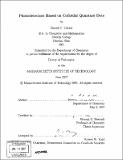| dc.contributor.advisor | Moungi G. Bawendi. | en_US |
| dc.contributor.author | Oertel, David C. (David Charles) | en_US |
| dc.contributor.other | Massachusetts Institute of Technology. Dept. of Chemistry. | en_US |
| dc.date.accessioned | 2007-12-07T16:16:15Z | |
| dc.date.available | 2007-12-07T16:16:15Z | |
| dc.date.copyright | 2007 | en_US |
| dc.date.issued | 2007 | en_US |
| dc.identifier.uri | http://hdl.handle.net/1721.1/39737 | |
| dc.description | Thesis (Ph. D.)--Massachusetts Institute of Technology, Dept. of Chemistry, 2007. | en_US |
| dc.description | Vita. | en_US |
| dc.description | Includes bibliographical references (p. 193-212). | en_US |
| dc.description.abstract | Inspired by recent work demonstrating photocurrent enhancement in quantum-dot (QD) solids via post-deposition chemical annealing and by recent successes incorporating single monolayers of QDs in light-emitting devices (QD-LEDs), we set out to develop thin-film, layered photodetectors in which the active layer is a chemically annealed QD solid. This thesis reports initial steps in this development. Chapters 1 and 2 contain introductory material. In Chapter 3, we demonstrate a layered QD photodetector (QD-PD) in which the active layer is a 200-nm thick film of CdSe QDs annealed with n-butylamine. These "thick-slab" devices, active in the visible spectrum, represent a minimal transformation from the transverse channel test structures employed for more fundamental studies to a layered, sandwich geometry. The thick-slab design exhibits a number of desirable characteristics, including near-unity internal quantum efficiency and a 50-kHz bandwidth. More complex QD-PD designs, allowing the successful incorporation of much thinner QD solids, are discussed in Chapter 4, and these devices provide insight into the zero-bias operation of thick-slab QD-PDs. | en_US |
| dc.description.abstract | (cont.) The final three chapters of the thesis focus on PbSe QDs, this group's initial material of choice for accessing the short-wavelength-IR spectral window. Initial study of PbSe QDs as a material for QD-PDs is described in Chapter 5. Chapter 6 discusses an 31P-based NMR investigation of the mechanism of PbSe monomer formation, allowing for rational "doping" of syntheses to increase chronically low yields. Finally, Chapter 7 discusses a brief assessment of the suitability of PbSe QDs for in vivo imaging. | en_US |
| dc.description.statementofresponsibility | by David C. Oertel. | en_US |
| dc.format.extent | 215 p. | en_US |
| dc.language.iso | eng | en_US |
| dc.publisher | Massachusetts Institute of Technology | en_US |
| dc.rights | M.I.T. theses are protected by copyright. They may be viewed from this source for any purpose, but reproduction or distribution in any format is prohibited without written permission. See provided URL for inquiries about permission. | en_US |
| dc.rights.uri | http://dspace.mit.edu/handle/1721.1/7582 | |
| dc.subject | Chemistry. | en_US |
| dc.title | Photodetectors based on colloidal quantum dots | en_US |
| dc.title.alternative | Photodetectors based on colloidal QDs | en_US |
| dc.type | Thesis | en_US |
| dc.description.degree | Ph.D. | en_US |
| dc.contributor.department | Massachusetts Institute of Technology. Department of Chemistry | |
| dc.identifier.oclc | 181375270 | en_US |
